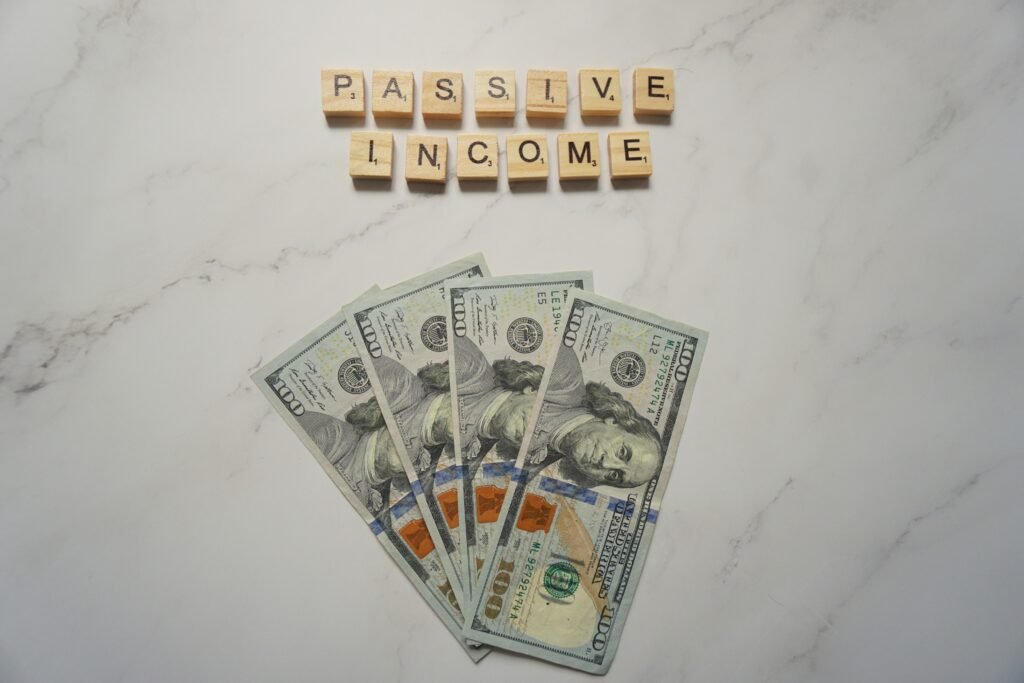
Passive Income Ideas Your Guide to Financial Freedom
Introduction to Passive Income
Passive income is a financial concept that refers to earnings derived from ventures in which an individual is not actively involved on a day-to-day basis. Unlike active income, which is earned through direct engagement in work—such as receiving a paycheck for a job—passive income allows individuals to generate revenue with minimal ongoing effort. This type of income can come from various sources, such as investments, rental properties, and online businesses, enabling individuals to create a steady flow of money without the constraints of traditional employment.
The significance of passive income in the pursuit of financial freedom cannot be overstated. Building a diverse portfolio of passive income ideas empowers individuals to enhance their financial security by developing multiple streams of income. With the increasing cost of living and economic unpredictability, relying solely on active income may not be sufficient for wealth accumulation or achieving long-term financial goals. Passive income serves as a safety net, allowing individuals to maintain their standard of living, even during periods of employment instability or economic downturns.
Moreover, passive income offers individuals the potential to allocate their time and resources more effectively. Instead of dedicating countless hours to work, individuals can invest their time in personal interests, hobbies, or furthering their education. This liberating aspect of passive income creates an opportunity for a balanced life, where financial aspirations align with personal growth and fulfillment. As we explore various passive income ideas throughout this guide, readers will discover how to harness opportunities that require minimal effort for maximum financial gain, thereby paving the way to financial independence.
Benefits of Passive Income
Passive income offers a plethora of advantages that can significantly enhance an individual’s financial landscape. One of the primary benefits is financial security. By establishing multiple streams of income, individuals reduce their reliance on a single paycheck, providing a safety net during unforeseen circumstances, such as job loss or economic downturns. This diversified approach not only stabilizes cash flow but also facilitates long-term wealth accumulation, setting the foundation for future financial independence.
Another compelling advantage of passive income is the flexibility it provides in lifestyle choices. When individuals are not solely dependent on their active job income, they can choose to work fewer hours or pursue work that aligns more closely with their passions. This freedom allows individuals to invest their time in personal interests, whether that involves developing a new skill or spending quality time with family. The ability to manage one’s schedule often leads to improved overall well-being and satisfaction in life.
Furthermore, passive income streams can help to alleviate the stress associated with monthly income reliance. The consistent revenue generated from sources like rental properties, dividends from stocks, or royalties from creative works can create a predictable financial environment. As people experience reduced financial stress, they often report higher levels of happiness and contentment. This newfound peace of mind encourages individuals to explore new opportunities, ultimately contributing to a positive feedback loop of personal and financial growth.
In summary, the advantages of passive income are profound and multifaceted, encompassing financial security, enhanced lifestyle flexibility, and reduced stress. By embracing various passive income ideas, individuals can not only work toward wealth generation but also achieve a higher quality of life, enabling them to focus on their personal aspirations and goals.
Real Estate Investing
Real estate investing has long been recognized as a reliable avenue for generating passive income. This form of investment can take various shapes, including rental properties, vacation rentals, and participation in Real Estate Investment Trusts (REITs). Each type of real estate investment carries its own unique advantages and challenges, which are essential to understand for anyone looking to build wealth through passive income ideas.
First, rental properties are an excellent way to create a steady stream of income. These properties can be single-family homes, multi-family buildings, or even commercial spaces. Investors typically acquire these properties, either by purchasing them outright or through financing, and then lease them to tenants, who pay monthly rent. The initial setup costs for rental properties can vary significantly based on factors such as location, property type, and condition. While the potential returns can be lucrative, investors must also be prepared for ongoing management tasks, including maintenance, tenant screening, and rent collection.
Another popular option is vacation rentals, which have gained traction due to platforms like Airbnb and Vrbo. They allow property owners to rent out short-term accommodations to travelers. This type of real estate investment can offer higher returns compared to traditional rental properties, especially in tourist-heavy areas. However, investors must consider factors like variable occupancy rates, seasonal demands, and the need for property management, which can be time-consuming.
Lastly, Real Estate Investment Trusts (REITs) offer a way for individuals to invest in real estate without the complexities of property management. By purchasing shares in a REIT, investors can access a diversified portfolio of real estate assets and benefit from potential dividends. This approach may involve lower initial investments and a more hands-off perspective, making it appealing for those who seek passive income ideas without direct involvement in managing properties.
Dividend Stocks and Investments
Dividend stocks are shares of publicly traded companies that return a portion of their profits to shareholders in the form of dividends. These payments are typically made on a quarterly basis, providing investors with a steady stream of passive income. The appeal of dividend stocks lies not only in their potential for regular income but also their capacity for capital appreciation, making them an attractive investment for both income-focused and growth-oriented investors.
Investing in dividend stocks can be beneficial for several reasons. Firstly, they offer a reliable income source, especially in economic downturns when traditional investment options may falter. Over time, reinvesting dividends can significantly increase overall returns, creating a snowball effect that enhances wealth accumulation. Furthermore, dividend-paying companies are often well-established with a history of stable earnings, providing additional security for investors.
When selecting the right dividend stocks, investors should consider several factors, including dividend yield, payout ratio, and company fundamentals. The dividend yield measures the annual dividend payment relative to the stock price, while the payout ratio indicates the percentage of earnings paid out as dividends. A lower payout ratio can signify sustainability, although high-yield stocks should be evaluated carefully as they might represent higher risk. It is essential to conduct comprehensive research and look into a company’s financial health, competitive position, and dividend history before making investment decisions.
Moreover, developing a diversified portfolio that includes various dividend stocks across multiple sectors can mitigate risks and enhance income stability. This strategy allows investors to benefit from different market conditions while maintaining a consistent cash flow. In conclusion, dividend stocks stand out as a favored method among passive income ideas, offering both regular income and growth potential for discerning investors.
Creating an Online Course
In recent years, the creation and sale of online courses have gained significant traction as a lucrative passive income option. This trend is driven by the increasing demand for accessible, high-quality educational content across various fields. Successfully launching an online course involves several key steps that can facilitate earning passive income without continuous active involvement.
The first step is to identify a niche where you possess expertise and that has a target audience eager to learn. Thorough market research is essential to ascertain current trends and demands, ensuring that the course content will resonate with potential students. Once a niche is established, the next step is to develop the course curriculum, balancing depth and accessibility to cater to learners of varying levels.
Content creation is a crucial component. Engaging materials such as videos, quizzes, and downloadable resources can enhance the learning experience. These elements should be structured logically, allowing students to progress smoothly through the material. A well-designed course not only imparts knowledge but also encourages retention and application of learned concepts.
After developing the content, selecting the right platform for hosting the online course is vital. Numerous platforms are available, including Udemy, Teachable, and Coursera, each offering unique features for course creators. These platforms enable creators to manage student enrollments, marketing, and payment processing, simplifying the administrative aspects of running an online course.
Effective marketing strategies are also essential to attract students. Utilizing social media, email marketing, and search engine optimization (SEO) can help increase visibility and drive enrollment. Consider the target audience’s preferences in selecting marketing channels. Additionally, offering limited-time promotions or free introductory lessons can incentivize individuals to enroll.
Lastly, optimizing course earnings requires ongoing engagement with students and continuous updates to course content based on feedback and industry advancements. This iterative process ensures that the course remains relevant and valuable. Implementing these strategies enables one to effectively leverage the potential of creating online courses as a sustainable source of passive income.
Blogging and Affiliate Marketing
Blogging has emerged as one of the most viable passive income ideas for creative individuals who possess a flair for writing and a niche they are passionate about. By starting a blog, individuals can not only share their insights and expertise but also monetize their content through affiliate marketing. This approach enables bloggers to earn commissions for promoting products or services through designated affiliate links embedded within their posts.
To successfully initiate a blog, one must first select a specific niche that aligns with personal interests and expertise. This choice is crucial, as it determines the audience’s relevance and engagement level. Once the niche is established, the next step is to choose a blogging platform—such as WordPress, Blogger, or Wix—that is user-friendly and offers various templates. After setup, consistent content creation becomes key to generating traffic, as search engines favor fresh, relevant content. Incorporating keyword optimization techniques can further enhance visibility, attracting more visitors to the blog.
Once a steady stream of traffic is established, bloggers can delve into affiliate marketing. Selecting reputable affiliate programs that resonate with the blog’s theme is essential for long-term success. Authors should choose products or services they genuinely recommend, as this builds trust with their audience. By strategically placing affiliate links within well-crafted blog posts, bloggers can drive their audience to make purchases, earning commissions on successful transactions.
To maintain a steady flow of income without constant effort, it is essential to create timeless, evergreen content. This type of content continues to attract readers long after its publication, enabling passive income generation. Engaging and informative blog posts not only foster reader loyalty but can also dramatically enhance sales conversions through optimized affiliate link placements. The synergy of a well-maintained blog and effective affiliate marketing can ultimately lead bloggers toward financial freedom.
Peer-to-Peer Lending
Peer-to-peer (P2P) lending has emerged as a viable alternative investment strategy, enabling individuals to generate passive income through direct loans to other individuals or small businesses. Utilizing online platforms that connect borrowers with lenders, P2P lending eliminates traditional financial institutions, offering a more streamlined and accessible approach to financing. Various platforms, such as LendingClub and Prosper, provide a user-friendly interface for investors to assess borrowers based on creditworthiness, loan purpose, and interest rates, facilitating informed investment decisions.
One of the primary benefits of P2P lending is the potential for attractive returns, often surpassing those typically offered by savings accounts or certificates of deposit. However, investing in P2P loans carries inherent risks, including borrower default. To mitigate these risks, it is vital for investors to diversify their loan portfolios across multiple borrowers and loan grades. By spreading their investments, lenders can better protect themselves against losses that may stem from individual borrower defaults, thereby enhancing their chances for overall profitability.
Additionally, understanding the borrower’s financial situation and assessing the loan’s purpose can help in selecting loans with a higher likelihood of repayment. Most reputable P2P platforms allow investors to review detailed borrower profiles, which include credit scores, loan history, and income information, among other factors. Engaging in due diligence when selecting loans can help investors maximize their passive income from this investment avenue.
In summary, peer-to-peer lending presents an attractive option for those seeking to diversify their investment portfolio and establish a steady stream of passive income. By understanding the various platforms, associated risks, and strategies for risk mitigation, investors can navigate this relatively new landscape effectively, making informed decisions that align with their financial goals.
Royalties from Creative Works
For creative individuals seeking passive income ideas, earning royalties from their works stands out as a compelling option. Royalties are payments made to creators for the use of their intellectual property, including books, music, and art. This revenue stream allows artists and authors to benefit financially from their efforts long after the initial creation process. By distributing their work across various platforms, creators can tap into multiple income streams, enhancing their financial security and freedom.
When it comes to publishing, platforms such as Amazon Kindle Direct Publishing for books, Spotify for music, and various online art galleries offer opportunities for creators to market their work effectively. These platforms facilitate access to a global audience, increasing the likelihood of generating consistent sales and royalty payments. Furthermore, using social media to promote creative endeavors can significantly boost visibility, further amplifying earning potential.
Royalties can come in different forms, including mechanical royalties from music sales, publishing royalties for written content, and licensing fees for artwork. Understanding these various types of royalties is crucial for creators to maximize their income potential. Additionally, protecting one’s intellectual property is paramount, as it ensures that creators retain control over their works and earn the revenues they deserve. Registering copyrights, using trademarks, and understanding how to navigate licensing agreements are essential steps in safeguarding creative outputs.
The long-term potential for passive income from creative works is significant. As creators continue to produce quality content, they can build a robust portfolio that generates income year after year. By leveraging their intellectual property effectively, artists and authors can enjoy a sustained source of income, aligning perfectly with the broader concept of generating passive income ideas. This not only provides financial benefits but also contributes to a fulfilling career centered around creativity and passion.
Conclusion and Next Steps
Exploring passive income ideas can be a transformative journey towards achieving financial freedom. Throughout this blog post, we have examined various strategies that can help you generate income with minimal ongoing effort. From real estate investments to dividend stocks and digital products, each of these methods offers unique advantages tailored to different lifestyles and preferences.
As you contemplate these passive income strategies, it is essential to take a step back and assess your current financial situation. Identifying your strengths, skills, and resources can provide valuable insights into which opportunities may be the most viable for you. For instance, if you have expertise in crafting digital content, creating an online course or writing an eBook can be effective avenues for passive income. Alternatively, if you prefer a more hands-on approach, investing in rental properties might align better with your goals.
Incorporating these passive income ideas into your life requires careful planning and a commitment to execute your chosen strategy. Start by setting realistic financial goals and timelines, then gradually work towards achieving them. Engaging with communities, whether online or locally, can also enhance your understanding and provide support as you navigate this new venture.
To further enhance your knowledge, consider exploring additional resources, such as books, webinars, or courses focused on specific passive income streams that intrigue you. The more informed you are, the more equipped you’ll be to make sound decisions regarding your investments and endeavors. Remember, the path to financial independence is a process; every step you take brings you closer to your objectives. Begin your journey today, and embrace the possibilities that lie ahead.

